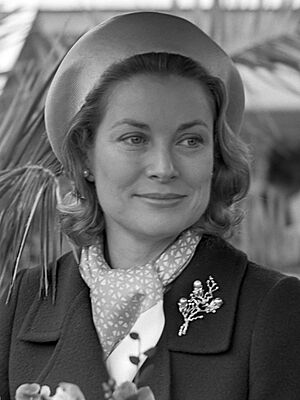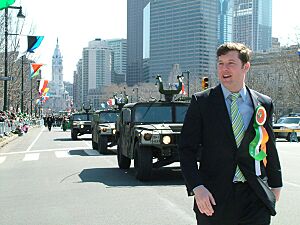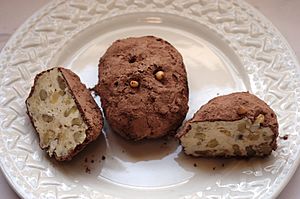History of Irish Americans in Philadelphia facts for kids
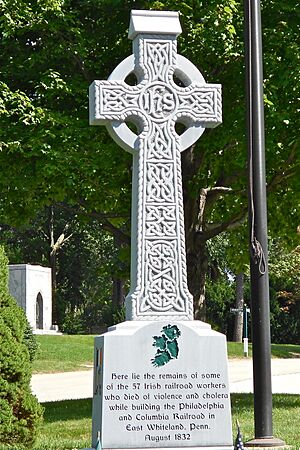
People of Irish background make up the largest ethnic group in Philadelphia and its nearby areas. Irish people have lived in Philadelphia since before the American Revolution. Many Irishmen helped with pro-Revolutionary activities during the American Revolutionary War.
In the 1800s, Philadelphia, once a Quaker city, changed a lot with new immigrants from Europe. The first big wave of Irish immigrants arrived in 1844. They came from rural areas, pushed by the terrible Irish Famine. Because Quakers believed in religious tolerance, Irish Catholics and Protestants made the city very diverse. Philadelphia needed workers for its growing industries, and Irish immigrants filled these jobs.
In the 1840s and 1850s, some people felt strongly against Catholics. This led to riots, like the Philadelphia nativist riots and the Lombard Street riot. Later in the 1800s, Irish Philadelphians gained more social and financial standing. They also started many important organizations. Many Irish Philadelphians later moved to other big American cities.
Philadelphia's Irish population has influenced the city in many ways. The Philadelphia Police Department and Philadelphia Fire Department have always had many Irish American members. Neighborhoods like Kensington, Fishtown, and Pennsport still have many Irish residents. A famous Irish Philadelphian was Grace Kelly, a well-known actress who became a Princess of Monaco. Important local politicians, like James Logan, also made a big impact. The Irish also helped create many Catholic schools, such as St. Joseph's University, La Salle University, and Villanova University.
Contents
History of Irish People in Philadelphia
Early American History
Irish people had a big impact on Philadelphia even before it was officially founded. William Penn, who started Philadelphia and Pennsylvania, had strong connections to Ireland. Penn became a Quaker after hearing a sermon in Cork, Ireland.
Irish Catholics were a noticeable group in the city before the Revolutionary War. Philadelphia had many Irish bars and taverns, like "Isabella Barry's Faithful Irishman." Irish people in Philadelphia were known for their patriotism during the Revolution.
The Society of the Friendly Sons of St. Patrick was started in 1771.
Philadelphia held its first St. Patrick's Day parade in 1771. Before this parade, Irish people in Philadelphia were already celebrating St. Patrick's Day. In 1771, Irishmen formed the Society of the Friendly Sons of St. Patrick. This group helped immigrants from Ireland. George Washington, who encouraged his Irish soldiers to celebrate St. Patrick's Day, was an honorary member. Celebrating March 17th was an early Philadelphia custom. Philadelphia's Saint Patrick's Day parade is the second oldest in the United States.
Many Irish soldiers fought in the Battle of White Marsh during the Philadelphia campaign in the Revolutionary War. John Barry was perhaps the most influential Irishman during the war. He is often called "The Father of the American Navy." He became a captain in the Continental Navy in 1775. He was the first captain to command a US warship under the Continental flag. After the war, he became America's first commissioned naval officer. President George Washington gave him the rank of commodore in 1797.
The 1800s and Irish Immigration
Many Irish groups were formed in the 1800s. The first mutual aid groups helped people from specific Irish counties, like County Donegal and County Mayo. The Total Abstinence Brotherhood encouraged Catholic values and avoiding alcohol. Groups like the Clan na Gael and the Fenian Brotherhood supported Irish nationalist movements. Some groups had Philadelphia chapters with their own meeting halls. These included the Ancient Order of the Hibernians and the Irish Catholic Benevolent Union.
Duffy's Cut Tragedy
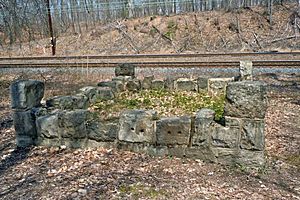
Duffy's Cut is a section of railroad tracks about 30 miles west of Philadelphia. It was built in 1832 for the Philadelphia and Columbia Railroad. This line later became part of the Pennsylvania Railroad. A contractor named Philip Duffy hired 57 Irish immigrants to build this track. The workers came from the Ulster counties of Donegal, Tyrone, and Londonderry. They came to work in Pennsylvania's new railroad industry.
Less than two months after they arrived, all 57 workers died during the second cholera pandemic. Most died from the disease. However, evidence suggests some might have been killed. This could have been due to fear of the disease, as the pandemic spread across many continents. The site is near Malvern, Pennsylvania, where a historical marker has been placed.
The Famine Generation Arrives
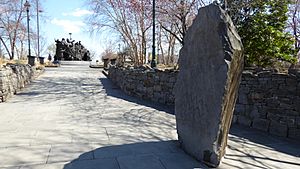
By 1846, Philadelphia had welcomed Irish immigrants for six generations. But the seventh generation greatly changed the city. The large number of Irish immigrants after the famine led to a "ghetto system." During the famine, the Society of Friends (Quakers) in Philadelphia worked hard to help those suffering in Ireland. Even though Quakers had faced challenges in Ireland in the 1600s, many of their descendants contributed a lot to help the Irish in the 1840s.
Riots and Social Tensions
The Lombard Street riot was a three-day race riot in 1842. It was one of many racial attacks in the city during that time. The riot started on Lombard Street. Before the riots, there were often fights between Irish Catholics, German Protestants, African Americans, and even Quakers. These fights happened because of competition for jobs and social status. Irish Catholics and African Americans often competed for the lowest-paying jobs.
Irish Catholics sometimes saw successful African Americans as showing off their achievements. This made African Americans targets for the immigrants' anger and jealousy.
On August 1, 1842, over 1,000 members of the black Young Men's Vigilant Association held a parade. They were celebrating the end of slavery in the British West Indies. As they neared Mother Bethel A.M.E. Church, an Irish Catholic group attacked them. The rioters moved west, setting fires and attacking firefighters and police. They headed for the home of African-American leader Robert Purvis. A Catholic priest reportedly saved Purvis and his home from the mob.
Requests for police protection at first led to the arrest of some victims, not the rioters. Over three days, many buildings were looted and burned. These included the Second African American Presbyterian Church and Smith's Hall. The mayor knew about a plan to burn churches but did not act. Eventually, the local militia was called in to restore order.
The Philadelphia Nativist Riots happened in May and July 1844. They took place in Kensington and Southwark. These riots were caused by growing anti-Catholic feelings against the increasing number of Irish Catholic immigrants. Before the riots, nativist groups spread rumors that Catholics wanted to remove the Bible from public schools.
A nativist rally in Kensington turned violent on May 6. This started a deadly riot that destroyed two Catholic churches and many other buildings. Riots started again in July. This happened after people found out that St. Philip Neri's Catholic Church had armed itself for protection. Fierce fighting broke out between the nativists and soldiers protecting the church. Many people died or were injured. Several Catholic churches were burned. These riots led to criticism of the nativist movement. They also showed problems with law enforcement in Philadelphia. This led to police reforms and the city's consolidation in 1854.
The 1900s and Prominent Families
In the 1900s, the Irish Center/Commodore Barry Club and the Irish American Club raised money for Irish causes.
The Kelly Family's Legacy
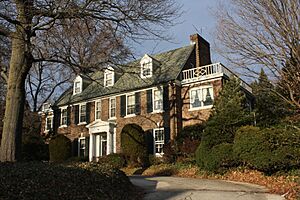
Philadelphia's most famous Irish family gained notice in the 1900s. Jack Kelly Sr. (1889–1960) won three Olympic gold medals for sculling. He owned a successful brickwork company. He was nominated to be mayor of Philadelphia in 1935 but lost by a very small margin. Later, he served on the Fairmount Park Commission. During World War II, President Roosevelt appointed him National Director of Physical Fitness. His brothers were also famous: Walter C. Kelly was a vaudeville star, and George Kelly won a Pulitzer Prize for his plays.
The most well-known Kelly family member was Grace Kelly. She was born in Philadelphia in 1929. She had two older siblings, Margaret and Jack Jr., and a younger sister, Elizabeth. The children were raised in the Roman Catholic faith. Grace started acting in 1950 at age 20. She appeared in New York plays and many TV shows. In 1953, she became a star with her role in the film Mogambo. This earned her a Golden Globe Award and an Academy Award nomination.
She then had leading roles in five more films. These included The Country Girl (1954), for which she won an Academy Award for Best Actress. Other films were High Noon (1952) with Gary Cooper, Dial M for Murder (1954) with Ray Milland, and Rear Window (1954) with James Stewart. She also starred in To Catch a Thief (1955) with Cary Grant and High Society (1956) with Frank Sinatra.
Grace Kelly stopped acting at age 26 to marry Rainier and become Princess of Monaco. They had three children: Caroline, Albert II, and Stéphanie. Kelly kept her American connections and had dual U.S. and Monégasque citizenship. She passed away in 1982 after a car crash caused by a stroke.
Even though the Irish had a huge impact on Philadelphia, the city did not have its first Irish Catholic mayor until 1962. James Tate was Mayor of Philadelphia from 1962 to 1972.
Another well-known Irish mayor was William J. Green III. As mayor, Green often had to make tough decisions. He had to balance a city budget with a huge deficit left by the previous mayor. This led to disagreements with worker unions and the City Council. His efforts to balance the budget were successful. New businesses started moving to Philadelphia. Green also appointed the first African American managing director, Wilson Goode, who later became mayor. He also appointed the first African American president of City Council, Joseph Coleman. The Green administration also brought young, talented people into city government.
Green chose not to run for re-election. He focused on his family because his wife was pregnant. After his youngest child was born healthy, Green joked that he was the "winner" of the 1983 mayoral race.
The 2000s and Continued Influence
Due to changes in the city's population, Irish people are no longer the most common ethnic group. This has changed some neighborhoods that were once mainly Irish, like Fishtown. However, the Irish still have a lasting impact on the city. In 2015, Philadelphia elected Irish American Jim Kenney as its 99th mayor. Several current local politicians of Irish descent include Pat Meehan, Brendan Boyle (a U.S. Representative), Mike Stack (a former Lieutenant Governor), and Patrick Murphy (a former Secretary of the Army).
Irish Culture in Philadelphia
Media and News
Since the 1800s, 18 Irish newspapers have been started. The Roman Catholic Archdiocese of Philadelphia newspaper, the Catholic Standard and Times, has covered news about Irish affairs since 1866.
Irish radio shows started in the 1900s. From 1926, Patrick Stanton's Irish Hour played Irish music and news. Stanton later bought WJMJ, which also played Irish music.
Arts and Entertainment
The Mummers Parade is a Philadelphia tradition since the early 1900s. It happens every New Year's Day in Philadelphia. It is thought to be the oldest folk festival in the United States. Many Irish immigrants and Irish Americans from South Philadelphia have been involved in the Mummers Parade.
Several Irish-themed bands have come from the area. The Green Fields of America is a group that performs and promotes Irish traditional music in the United States. "The Green Fields of America" was formed in 1978 in Philadelphia. It is still led by musician Mick Moloney. The band was created to showcase Irish American musicians and dancers. It was the first group to combine Irish singing, instruments, and dance on stage. They introduced their sound to general American audiences, often featuring Irish stepdance.
The TV show "It's Always Sunny in Philadelphia" is a well-known Philadelphia entertainment with an Irish theme. The show follows a group of friends who run an Irish bar called Paddy's Pub in South Philadelphia.
Delicious Irish-Inspired Treats
Irish potato candy is a traditional Philadelphia candy. Despite its name, it is not from Ireland and usually does not contain any potato. The candies have a coconut cream inside. This cream is usually made from coconut, confectioner's sugar, vanilla, and cream or cream cheese. They are rolled in cinnamon on the outside. This makes them look like small potatoes. These treats are about the size of a large marble. They are especially popular around St. Patrick's Day.
Oh Ryan's of Boothwyn, Pennsylvania, says it is the biggest seller of Irish Potatoes. They ship about 80,000 pounds to stores, mostly in the Philadelphia area. See's Candies also makes a version with a divinity and English walnut inside. It is dusted with cocoa and has pine nuts as "potato eyes." Supermarkets in the Philadelphia area, like Acme Markets, sell these potatoes as a seasonal item.
Sports and Irish Connections
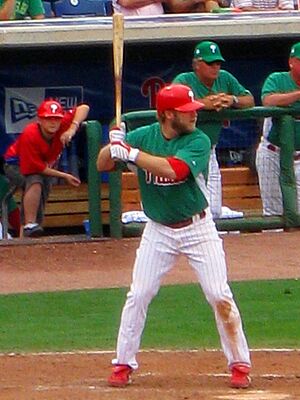
The Philadelphia Phillies baseball team always plays at home during spring training on St. Patrick's Day. The Phillies were the first baseball team to wear green uniforms on St. Patrick's Day. This tradition was started by Phillies pitcher Tug McGraw. He dyed his uniform green the night before March 17, 1981.
Rugby is a popular sport in the Philadelphia Irish community. The Philadelphia Whitemarsh RFC, a rugby union team, was founded in 1985. The Philadelphia Fight, a semi-professional rugby league team, was founded in 1998. The Northeast Philadelphia Irish team was founded in 2011 and has both men's and women's clubs.
Many colleges in the area have club rugby teams. Most teams compete as part of the Eastern Pennsylvania Rugby Union. The Collegiate Rugby Championship (CRC) is a college rugby sevens tournament. It is held every June near Philadelphia. The CRC is the biggest college rugby competition in the United States. It is broadcast live on NBC every year. Philadelphia also takes part in hurling, camogie, and Gaelic football. These sports are part of the Philadelphia Division GAA Board.
Irish Population in Philadelphia
Philadelphia has a high percentage of Irish Americans, making up 14.2% of the population. Due to changes in the city's population, most of Philadelphia's Irish residents now live in the suburbs. Many nearby towns have large Irish populations. Examples include Crum Lynne, Pennsylvania (39.2% Irish), Drexel Hill, Pennsylvania (37.9% Irish), and Gloucester City, New Jersey (38.8% Irish). Havertown, Pennsylvania (21.7% Irish) is often called the "33rd county," referring to the 32 counties of Ireland.
Famous Irish Philadelphians
- Kevin Bacon, actor, musician
- Samuel Barber, composer
- Brendan F. Boyle, politician
- Kevin J. Boyle, politician
- Peter Boyle, actor
- John Barry, Revolutionary War naval officer, "Father of the American Navy"
- Ethel Barrymore, actress, "First Lady of the American Theater"
- John Barrymore, actor
- Lionel Barrymore, actor, director
- Georgiana Drew Barrymore, actress
- Bob Brady, politician
- Samuel Brady, Irish colonial Indian fighter
- Joseph Breen, film censor
- Gia Carangi, supermodel
- Mathew Carey, publisher, economist
- Imogene Coca, actress, comedian
- Bradley Cooper, actor, producer
- Kim Delaney, Emmy Award-winning actress
- John Drew Jr., stage actor
- Kate Flannery, actress
- Franklin B. Gowen, President of Philadelphia and Reading Railroad
- John Joseph Graham, Auxiliary bishop
- William J. Green Jr., politician
- William J. Green III, 94th mayor
- Alexander Haig, Army general, 59th Secretary of State
- William Harnett, painter
- Edward "Babe" Heffron, soldier, "Band of Brothers"
- Bobby Henon, politician
- Edward Hughes, bishop
- William F. Keller, politician
- Dorothy Kelly, actress
- George Kelly, playwright, screenwriter, director, and actor
- Grace Kelly, actress, Princess of Monaco
- Jack Kelly Jr., four-time Olympian rower
- Jack Kelly Sr., triple Olympic gold medal winner, patriarch of Kelly family
- Walt Kelly, animator, cartoonist
- Jamie Kennedy, actor, comedian
- Jim Kenney, 99th mayor
- James V. Lafferty, inventor
- James Logan, 14th mayor, statesman
- Jeanette MacDonald, actress, singer
- Chris Matthews, political commentator, talk show host, and author
- Seamus McCaffery, Justice of Supreme Court of Pennsylvania
- John McDermott, professional golfer, U.S. Open champion
- Maje McDonnell, baseball coach, scout
- Brian McDonough, Television and Radio personality, author, physician
- Joseph McGarrity, founder, Society of the Friendly Sons of Saint Patrick for the Relief of Emigrants
- Mike McGeary, baseball player
- Kathleen McGinty, Chair of the Council on Environmental Quality
- Rob McElhenney, actor, comedian, creator of It's Always Sunny in Philadelphia
- Joseph P. McFadden, auxiliary bishop, Bishop of Harrisburg
- Henry Plumer McIlhenny, chairman of the Philadelphia Museum of Art
- Jim McKay, television sports journalist
- Joseph McKenna, 42nd United States Attorney General
- Benny McLaughlin, 1948 Olympic soccer player
- James McNulty (Irish activist), commandant of the Doe Battalion, 1916 Easter Rising
- Chris Mooney, basketball coach
- Alecia Beth "Pink" Moore, singer, songwriter, dancer, actress
- St. Clair Augustine Mulholland, American Civil War colonel, Medal of Honor recipient
- Patrick Murphy, politician, Secretary of the Army
- Jim Murray, co-founder of the Ronald McDonald House
- Philadelphia Jack O'Brien, world light heavyweight boxing champion
- Fran O'Hanlon, basketball coach
- Danny Rapp, singer
- Ed Reavy, fiddler and composer
- Michael J. Stack, politician
- Mike Stack (III), 33rd Lieutenant Governor of Pennsylvania
- James Tate, 92nd mayor, first Irish Catholic mayor
- Charles Thomson, secretary of the Continental Congress
- Brian Tierney, publisher of The Philadelphia Inquirer
- William Wrigley Jr., chewing gum industrialist
- John Russell Young, seventh Librarian of the United States Congress
- Sean Tobin, Television Reporter
See also
- Irish Americans
- Demographics of Philadelphia
- Northeast Philadelphia
- Friendly Sons of St. Patrick
- Green Fields of America




